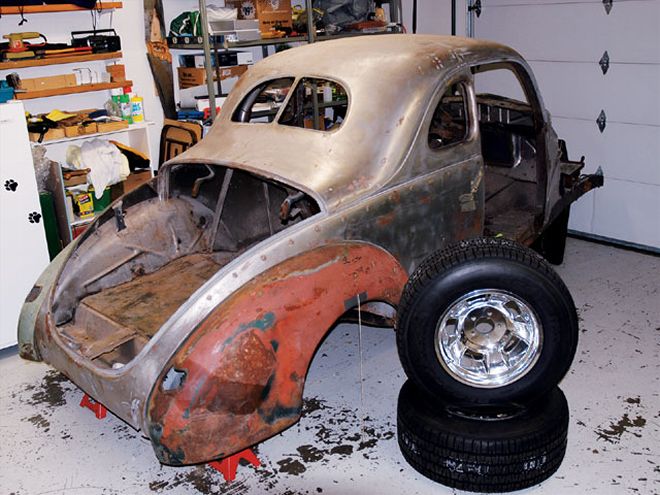

Ask someone who builds race cars for a living and they'll quickly tell you a car should be built around the wheels and tires (particularly the back ones). Some hot rods and customs are fabricated that way too, but plenty aren't. If a car isn't constructed around the rear rolling stock, there's a pretty good chance the wheel fit, along with the ride height (in other words, the all-important stance), will never be right. There's more here too: One of the biggest screw-ups in all of hot rodding is measuring a car for a new rearend housing, then getting it all wrong. Fixing it means expensive bits like wheels, tires, and custom axlehousings have to be swapped. You can feel your Visa card melting in your jeans.
So, how do you measure for a rearend and get it right? Each hot rod is different. That's no secret. But if you have the back wheels and tires in hand (mounted), that's the only piece of the puzzle, aside from the car, that you'll need. In a few cases, it's simply a matter of jamming the wheel and tire combination up inside the existing wheelwell, squaring the works up in the chassis, and measuring between the respective wheel mount flanges. You're pretty much done. But what if you have to chop up the floor, cut out the wheeltubs, narrow the frame, and Z the 'rails before anything fits? And what if you don't want to cut up anything before you have a new frame to slide under the car? After all, the floor is one of the few structural pieces that holds the body together for some cars. If you drag out the Sawzall or a gas axe too soon, you have to deal with a carcass that's nothing more than a flexi-flier. That makes a simple job like moving the body around the shop difficult. It also means you really can't complete any bodywork. That's the situation I was faced with my '40 Ford coupe project.
You'll need a couple of plumb bobs, a tape measure, a carpenter's square, and a straightedge to come up with the appropriate numbers; some duct tape, a Sharpie marker, and a hand calculator will come in handy too.
Brake Stand-OutSymmetrical Ends - 2.834"Large Ford Ends - 2.500"Olds Ends - 2.834"Small Ford Ends - 2.500"Mopar Ends - 2.500"GM 10-12-bolt Ends - 2.812"Illustration courtesy Mark Williams Ent.
DO THE MATH Overall car width, outside of fender to outside of fender 69.500" Lamb standard brake stand-out: 2.834" (each) x 2 -5.668" {{{M}}}-W hat thickness: 0.250-inch (each) x 2 -0.500" Wheel & tire face to mount flange: 7.3125-inch x 2 -14.625" Fender Clearance: 3.00-inch (each) x 2 -6.00" Rearend width (housing end to housing end)Offsets, Odds & EndsIf you're building a rearend housing from scratch, or if you're having one built for you, two big considerations are pinion offset as well as the housing end you choose to use. In many cases, rodders just use what was there. That might be fine for some cars, but for others, it's simply asking for trouble. Here's why:
Pinion offset: Typically, many production cars do not have centered engines. They're often offset toward the passenger side of the vehicle. To compensate, the pinion in these applications is also offset (for example, in some later-model Fords, the offset is just under 1.00 inch). That means the passenger-side axle is shorter than the driver-side axle. This is very common, almost standard. George Cathey at Pro Designs echoes that comment, but goes on to point out that the pinion should be centered in a race car application, or one where the driveshaft is very short. That means the housing is constructed in such a way that the offset is taken into consideration. The bottom line here is, it's not a good idea to the have the driveshaft angle skewed in the car.
Housing ends: When it comes to selecting housing ends, the rearend pros recommend you select the housing end based upon the brake system you plan on using. Mark Williams recommends using the big-bearing Ford end over the small-bearing Ford housing ends because they're a lot beefier and less prone to breakage.